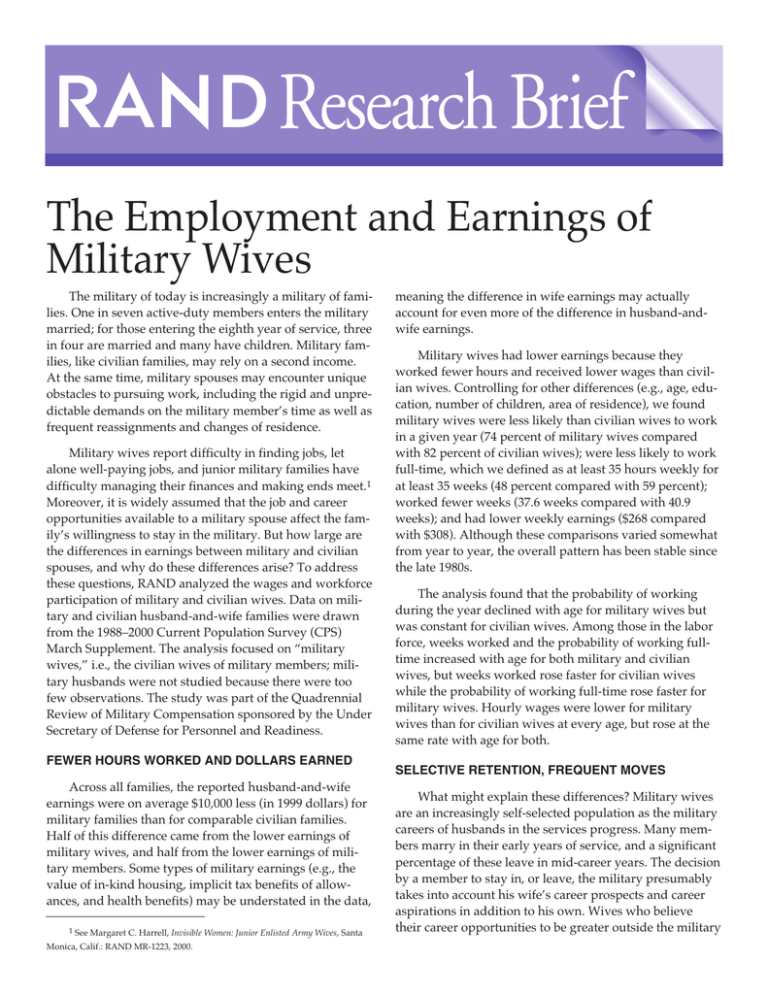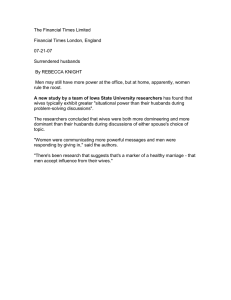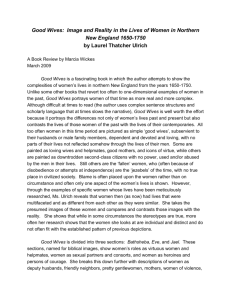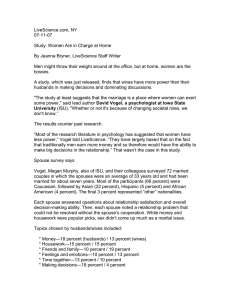The Employment and Earnings of Military Wives
advertisement

The Employment and Earnings of Military Wives The military of today is increasingly a military of families. One in seven active-duty members enters the military married; for those entering the eighth year of service, three in four are married and many have children. Military families, like civilian families, may rely on a second income. At the same time, military spouses may encounter unique obstacles to pursuing work, including the rigid and unpredictable demands on the military member’s time as well as frequent reassignments and changes of residence. Military wives report difficulty in finding jobs, let alone well-paying jobs, and junior military families have difficulty managing their finances and making ends meet.1 Moreover, it is widely assumed that the job and career opportunities available to a military spouse affect the family’s willingness to stay in the military. But how large are the differences in earnings between military and civilian spouses, and why do these differences arise? To address these questions, RAND analyzed the wages and workforce participation of military and civilian wives. Data on military and civilian husband-and-wife families were drawn from the 1988–2000 Current Population Survey (CPS) March Supplement. The analysis focused on “military wives,” i.e., the civilian wives of military members; military husbands were not studied because there were too few observations. The study was part of the Quadrennial Review of Military Compensation sponsored by the Under Secretary of Defense for Personnel and Readiness. FEWER HOURS WORKED AND DOLLARS EARNED Across all families, the reported husband-and-wife earnings were on average $10,000 less (in 1999 dollars) for military families than for comparable civilian families. Half of this difference came from the lower earnings of military wives, and half from the lower earnings of military members. Some types of military earnings (e.g., the value of in-kind housing, implicit tax benefits of allowances, and health benefits) may be understated in the data, 1 See Margaret C. Harrell, Invisible Women: Junior Enlisted Army Wives, Santa Monica, Calif.: RAND MR-1223, 2000. meaning the difference in wife earnings may actually account for even more of the difference in husband-andwife earnings. Military wives had lower earnings because they worked fewer hours and received lower wages than civilian wives. Controlling for other differences (e.g., age, education, number of children, area of residence), we found military wives were less likely than civilian wives to work in a given year (74 percent of military wives compared with 82 percent of civilian wives); were less likely to work full-time, which we defined as at least 35 hours weekly for at least 35 weeks (48 percent compared with 59 percent); worked fewer weeks (37.6 weeks compared with 40.9 weeks); and had lower weekly earnings ($268 compared with $308). Although these comparisons varied somewhat from year to year, the overall pattern has been stable since the late 1980s. The analysis found that the probability of working during the year declined with age for military wives but was constant for civilian wives. Among those in the labor force, weeks worked and the probability of working fulltime increased with age for both military and civilian wives, but weeks worked rose faster for civilian wives while the probability of working full-time rose faster for military wives. Hourly wages were lower for military wives than for civilian wives at every age, but rose at the same rate with age for both. SELECTIVE RETENTION, FREQUENT MOVES What might explain these differences? Military wives are an increasingly self-selected population as the military careers of husbands in the services progress. Many members marry in their early years of service, and a significant percentage of these leave in mid-career years. The decision by a member to stay in, or leave, the military presumably takes into account his wife’s career prospects and career aspirations in addition to his own. Wives who believe their career opportunities to be greater outside the military will influence members to leave the military, other things being equal. In particular, wives with a stronger interest in the labor market will influence their husbands to leave the military if they believe labor market opportunities are greater outside the military. This helps explain the decline with age in the fraction of military wives who work during the year. In addition, of the wives remaining with the military, the ones with a weaker attachment to the labor force tend to withdraw from it. Military wives withdrawing from the labor force may devote more time to on-base activities (e.g., supporting junior or recently relocated families), as is customarily expected of the wives of higherranking personnel, or simply to personal activities. Military wives remaining in the workforce see an increase with age in both their weeks worked and their full-time workforce participation, although these always remain lower than those for civilian wives. the probability of work in a year, the probability of fulltime work, and weeks of work. These effects decreased as the children grew older. The more frequent moves of military families reduce military wives’ weeks of work and may be an important factor in their lower wages. One in 4 military families move across county lines in a given year, compared with 1 in 12 civilian families. Military wives lose fewer weeks of work than civilian wives for a move of a given length, but the greater frequency and distance of their moves mean military wives lose more work time to moves than do civilian wives. Furthermore, knowing they are likely to move frequently, military wives may be willing to accept jobs at lower wages rather than spending more time at their new location to find a higher-wage job. A military wife also may accept work at a lower wage if it offers the flexibility needed to accommodate her husband’s rigid and unpredictable schedule. Employers, knowing military wives move frequently, condition their job offers on the expectation that a military wife will not be with a firm long and that she faces a trade-off between searching longer for a higher wage and starting work at a lower wage. Nevertheless, military wives appear to accumulate human capital at the same rate as civilian wives, as demonstrated by the fact that their hourly wages grow at the same rate with age. DIRECTIONS FOR FUTURE RESEARCH The effects of location were not substantial. It is often assumed that military families are more likely to live in rural areas where job opportunities are poor (i.e., fewer or less lucrative), but there are actually fairly small differences in the effects of location on civilian and military families. Moreover, contrary to common expectations, the analysis found little difference in the wages of military wives in urban, suburban, and rural areas; wages for military wives were only 4 percent lower in rural areas than in suburban areas. This may reflect a “micro-economy” around a base, stabilized by a steady flow of funds to the base. In contrast, wages for civilian wives were 28 percent lower in rural areas than in suburban areas. This research quantifies the extent to which military wives have lower earnings, suggests reasons why that is so, and points to several unanswered questions, including • How important are the wife’s job opportunities and career aspirations in military family retention decisions? • Would reducing the frequency of military family moves increase the earnings of military wives? Would this occur only because of a resulting increase in weeks worked, or would wages also increase? • In addition to a policy reducing the frequency of military moves, would expanded family support programs, particularly child care, help retain military members and their families? • Do wives have access to affordable education and training programs to prepare for better-paying jobs as military wives or for civilian careers? Would greater access to or lower costs for such programs increase military family retention? • Should military families be compensated for the weeks of work a wife loses from frequent moves? If so, how much should this compensation be? The effects of children on work were similar for military and civilian wives. Having young children reduced RAND research briefs summarize research that has been more fully documented elsewhere. This research brief describes work conducted by the National Security Research Division; it is documented in Married to the Military: The Employment and Earnings of Military Wives Compared with Those of Civilian Wives by James Hosek, Beth Asch, C. Christine Fair, Craig Martin, and Michael Mattock, MR-1565-OSD, 2002, 134 pp., $20.00, ISBN: 0-8330-3180-5, available from RAND Distribution Services (Telephone: 310-451-7002; toll free 877-584-8642; FAX: 310-451-6915; or email: order@rand.org). Abstracts of RAND documents may be viewed at www.rand.org. Publications are distributed to the trade by NBN. RAND® is a registered trademark. RAND is a nonprofit institution that helps improve policy and decisionmaking through research and analysis; its publications do not necessarily reflect the opinions or policies of its research sponsors. R 1700 Main Street, P.O. Box 2138, Santa Monica, California 90407-2138 • Telephone 310-393-0411 • FAX 310-393-4818 1200 South Hayes Street, Arlington, Virginia 22202-5050 • Telephone 703-413-1100 • FAX 703-413-8111 201 North Craig Street, Suite 202, Pittsburgh, Pennsylvania 15213-1516 • Telephone 412-683-2300 • FAX 412-683-2800 RB-7555-OSD (2003)





